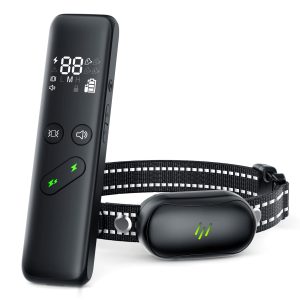Hey there, fellow dog lover! So, you’ve been thinking about using a shock collar for training your furry friend, huh? Well, let’s sit down and have a little chat about the pros and cons of shock collars, so you can make an informed decision. After all, we all want what’s best for our four-legged companions, right?
What is a Shock Collar
First things first, what exactly is a shock collar? A shock collar, also known as an electronic collar or e-collar, is a training device that delivers a mild electric shock to a dog’s neck to correct undesirable behaviors or reinforce obedience commands. The collar typically consists of two main parts: a receiver and a transmitter. The receiver is a small, lightweight unit that attaches to the dog’s collar, while the transmitter, usually in the form of a handheld remote, is used by the trainer to activate the shock.
The receiver is equipped with two metal prongs that make contact with the dog’s skin when the collar is worn. When the trainer activates the shock, an electrical current is sent through these prongs, delivering a brief and mild sensation to the dog’s neck. This sensation can be described as a static shock, similar to what you might feel after walking across a carpeted floor and touching a metal object.
Shock collars come with various features and options that can be adjusted to suit each dog’s needs and the trainer’s preferences. Here are some key aspects of shock collars:
- Stimulation levels: Shock collars offer multiple levels of stimulation, ranging from very mild to more intense. This allows trainers to choose the appropriate level for their dog, ensuring that the shock is not too weak to be effective or too strong to cause unnecessary discomfort. In general, it is recommended to start with the lowest level of stimulation and gradually increase it until the dog responds appropriately.
- Vibration and tone modes: In addition to the shock feature, many shock collars also include vibration and tone options. Vibration mode delivers a non-electric pulsation to the dog’s neck, while tone mode emits an audible sound. These alternative stimuli can be used for different purposes, such as warning the dog before a shock is delivered or reinforcing positive behavior without using the shock function.
- Range: The range of a shock collar refers to the maximum distance between the transmitter and the receiver at which the device will still function effectively. Some shock collars have a range of up to 1,000 feet or more, allowing trainers to maintain control of their dogs even when they are off-leash or at a considerable distance.
- Waterproofing: Many shock collars are designed to be waterproof or water-resistant, which is particularly useful for dogs that love to swim or play in wet conditions. This feature ensures that the collar continues to function effectively even when exposed to moisture, protecting both the device and the dog’s safety.
- Bark detection: Some shock collars come with a built-in bark detection feature that automatically delivers a shock when the dog barks. This can be particularly useful for addressing nuisance barking, as it eliminates the need for the trainer to be present and manually activate the shock.
- Safety features: Modern shock collars often include safety features to protect the dog from harm, such as an automatic shut-off function that prevents continuous stimulation for an extended period. This helps to ensure that the dog is not accidentally exposed to excessive shocks due to a malfunction or user error.
While shock collars can be an effective tool for training dogs, they should be used responsibly and as part of a comprehensive training program that focuses on positive reinforcement, communication, and building a strong bond between the dog and its trainer.

Pros And Cons
Now, let’s dive into the pros and cons of shock collars.
Pros:
- Fast results: One of the main reasons people turn to shock collars is that they can yield quick results. Dogs are smart, and they quickly learn to associate the unpleasant shock with the unwanted behavior. So, you might see your dog’s behavior change in just a few days!
- Control from a distance: With a remote-controlled shock collar, you can give your dog commands from far away. It’s a great advantage if your dog loves to wander off or if you’re training him to stay within a certain boundary.
- Customizable settings: Many shock collars come with adjustable settings, allowing you to control the intensity of the shock. This means you can start with a low level and increase it if needed, ensuring your dog isn’t subjected to unnecessary pain.
- Effective for stubborn dogs: Let’s face it, some dogs can be pretty stubborn. For those hard-to-train pups, a shock collar can be an effective tool to break through their resistance and get them to listen.
Now, for the not-so-great side of things…
Cons:
- Ethical concerns: Some people view shock collars as inhumane, arguing that causing pain to correct behavior is cruel. It’s important to consider how you feel about this issue before using a shock collar on your dog.
- Risk of overuse: There’s a chance that you might rely too heavily on the shock collar, using it for every little disobedience. Overusing the collar can lead to anxiety, fear, and even aggression in your dog.
- Can create negative associations: Dogs might associate the shock with something else in their environment instead of the behavior you’re trying to correct. For example, if your dog is shocked every time they bark at a passing stranger, they might become fearful or aggressive towards strangers instead of learning not to bark.
- Doesn’t address the root cause: Using a shock collar might stop the unwanted behavior, but it doesn’t necessarily address the underlying reason for the behavior. For instance, if your dog barks excessively due to anxiety, a shock collar might stop the barking, but it won’t help your dog feel less anxious.
So, what’s the verdict? Well, it’s really up to you. Every dog is different, and what works for one pup might not work for another. Just remember, there are other training methods out there, like positive reinforcement, that you can try before turning to a shock collar.
In the end, the most important thing is that you and your furry pal have a strong, loving bond. Whichever training method you choose, make sure it’s done with love, patience, and understanding. After all, our dogs are more than just pets – they’re family!
Additional Resources:
Shock Collar for Dogs Reviews
Understanding Dog Body Language; Signals and Behaviors
https://www.vettails.com/vettails/the-the-use-of-electric-collars-from-the-vets-and-dog-trainers-perspective




